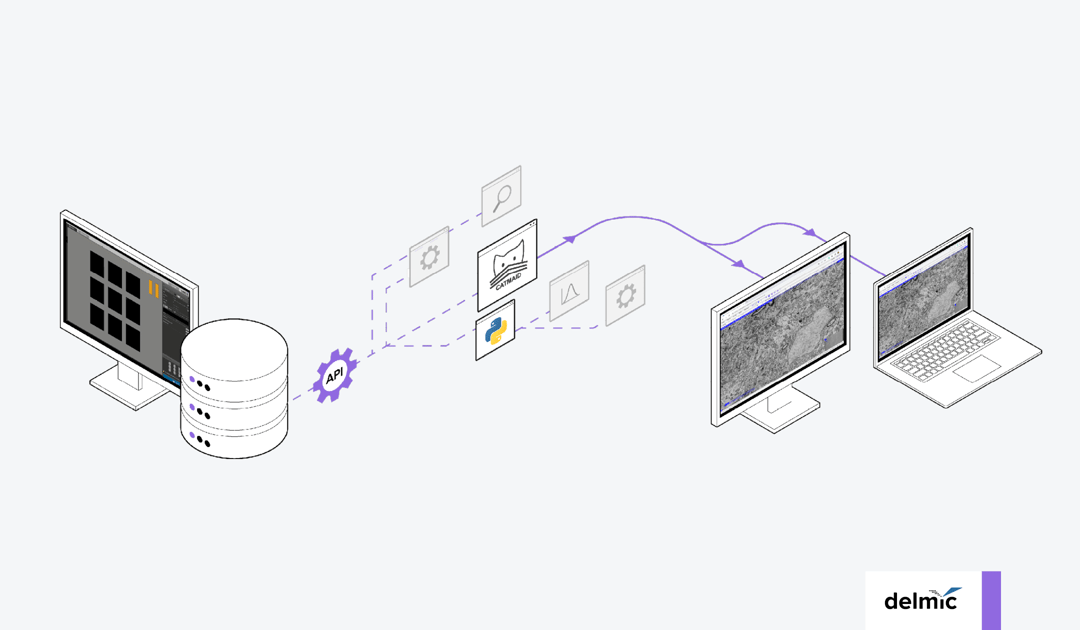Most modern scanning electron microscopes make it possible to visualize samples at nanometer resolution. Using SEM, biologists are therefore able to analyze the ultrastructures of a biological specimen and advance their understanding of cellular processes.
One of the major limitations of the technique had been its relatively low throughput. The recent developments were aimed therefore at increasing the throughput and led to an introduction of multi-beam scanning electron microscopes. Utilizing the resulting multi-beam systems, such as our FAST-EM, scientists can now acquire larger datasets orders of magnitude faster. Scientists can acquire data from many more samples within the same amount of time it used to take for one sample. This is particularly beneficial in studies where there is a need for quantitative analysis, for example, imaging of biological material from many patients or comparing large numbers of tissues treated in different ways or at different time points. It is also the only manageable electron microscopy (EM) approach to studying large objects such as a 1 mm cube of biological material.
The fundamental change in data acquisition capability creates however a new challenge to the subsequent stages in the SEM workflow - data transfer, analysis and sharing.
To remove the ensuing bottlenecks and create an end-to-end, sample-to-insight solution, we teamed up with specialists from Technolution Advance (1). Our goal was simple: create a high-speed technology for high-throughput SEM data transfer and enable maximum flexibility in the processing of the data. The resulting platform offers local storage for up to 2 petabytes of data. Even more importantly, researchers now have the ability to stream the data from the storage directly to any compatible software package, or any custom-built software algorithms (for example written in Python) that they are using to process the EM data. This is possible thanks to an Application Programming Interface (API) that allows the extraction of the relevant portions of the datasets, at the defined (x, y, z) coordinates and zoom level, and making it available directly when needed.
The streaming capability means that no data needs to be loaded to a computer. As a result, there is no risk of clogging computer memory thus allows users to run complex analyses faster. Furthermore they can process data in a more automated way.
One of the implementations already existing on the platform enables the FAST-EM users to stream EM images of the regions of interest, pre-stitched, on CATMAID. This allows the users to directly navigate the images, zooming in and out in a similar fashion as in the Google Maps app, immediately after acquisition. Moreover, through the API, researchers who have their special in-house developed tools can stream the EM data to these software algorithms, for example to segment the images, select, annotate or count the number of distinct objects, or perform other sophisticated image analyses. In this sense, the platform provides great grounds for researchers to develop specialized apps to process and analyze their data in the way they desire.
The streaming of the data from FAST-EM to a data-processing app ultimately creates a robust pipeline, from sample to information. To our best knowledge, this approach to high-throughput SEM data management is so far unique.
Curious to see how the platform works? Check the demo that we recently performed.
High-throughput SEM technology is redefining the capabilities of electron microscopy. When high-resolution imaging is required for large samples and both nanoscale and macroscale information are important, high-throughput SEM offers unparalleled advantages. To truly accelerate scientific discoveries with the high-throughput SEM, however, data handling for electron microscopy requires a completely new approach. In our quest to provide scientists with more effective, time-saving, and user-friendly EM solutions, we made sure that the phenomenal data acquisition capability of our ultra-fast multibeam SEM (FAST-EM) comes with equally capable data storage and management platform.
Learn more about the FAST-EM and how it has benefited the work of our customers - download our brochure below.
References
1. Technolution Advance - “FAST-EM High-speed electronics for a multi-beam scanning electron microscope” - link
.png)









